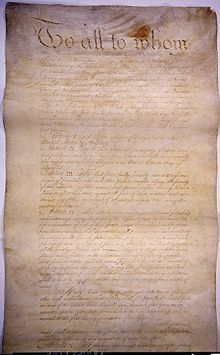Articles of Confederation and Perpetual Union
| Articles of Confederation | |
|---|---|

Page I of the Articles of Confederation
|
|
| Created | November 15, 1777 |
| Ratified | March 1, 1781 |
| Location | National Archives |
| Author(s) | Continental Congress |
| Signatories | Continental Congress |
| Purpose | First constitution for the United States; replaced by the current United States Constitution on September 13, 1788 |
The Articles of Confederation, formally the Articles of Confederation and Perpetual Union, was an agreement among the 13 original states of the United States of America that served as its first constitution. Its drafting by a committee appointed by the Second Continental Congress began on July 12, 1776, and an approved version was sent to the states for ratification on November 15, 1777. The Articles of Confederation came into force on March 1, 1781, after being ratified by all 13 states. A guiding principle of the Articles was to preserve the independence and sovereignty of the states. The federal government received only those powers which the colonies had recognized as belonging to king and parliament.
The Articles formed a war-time confederation of states, with an extremely limited central government. Even unratified, the document was used by the Congress to conduct business, direct the American Revolutionary War, conduct diplomacy with foreign nations, and deal with territorial issues and Native American relations. Actually the adoption of the Articles made no perceptible change in the federal government, because it did little more than legalize what the Continental Congress had been doing. That body was now taken over as the Congress of the Confederation; but Americans continued to call it the Continental Congress, since its organization remained the same.
As the Confederation Congress attempted to govern the continually growing American states, delegates discovered that the limitations placed upon the central government rendered it ineffective at doing so. As the government's weaknesses became apparent, especially after Shays' Rebellion, individuals began asking for changes to the Articles. Their hope was to create a stronger national government. Initially, some states met to deal with their trade and economic problems. However, as more states became interested in meeting to change the Articles, a meeting was set in Philadelphia on May 25, 1787. This became the Constitutional Convention. It was quickly realized that changes would not work, and instead the entire Articles needed to be replaced. On March 4, 1789, the general government under the Articles was replaced with the federal government under the Constitution. The new Constitution provided for a much stronger federal government by establishing a chief executive (the President), courts, and taxing powers.
...
Wikipedia
